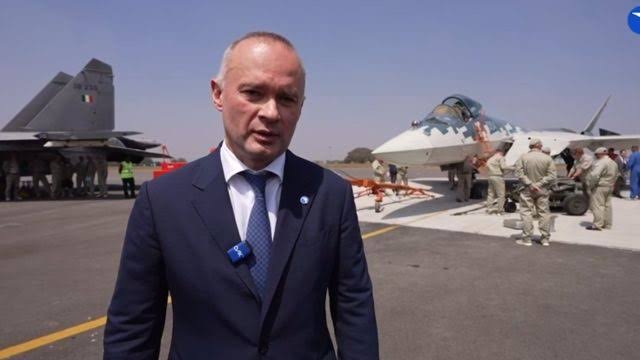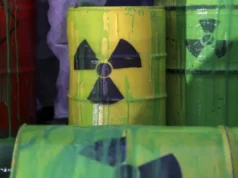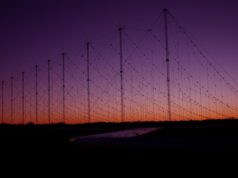UAC officially confirms Su-57 co-production offer to India

By Boyko Nikolov
United Aviation Cooperation [UAC] is offering India co-production of its Sukhoi 57 fighters.
This was confirmed by Vadim Badekha, the head [CEO] of the UAC, in an interview with Russian media.
“The Su-57 is needed by the Indian Air Force as the next step in the evolution and development of our aviation industries,” Badekha said.
“India’s assessment of the Su-57 is positive. Everyone sees that this is the only fifth-generation fighter jet that regularly participates in combat operations, demonstrating its best qualities and technical characteristics,” Badekha continued.
“We offer joint development with India of the Su-57. We offer joint production of the Su-57 here, in India,” Badekha concluded his interview.
The offer of co-development and production in India aligns with New Delhi’s longstanding interest in advanced fighter technology. India previously engaged with Russia on the Fifth Generation Fighter Aircraft [FGFA] program, which aimed to develop a variant of the Su-57 tailored to Indian requirements.
However, the FGFA program stalled in 2018 due to concerns over cost, technology transfer, and the developmental status of the Su-57 at the time.
Since then, India has continued its pursuit of advanced fighter aircraft, including domestic initiatives like the Advanced Medium Combat Aircraft [AMCA] and exploration of Western alternatives.
Russia’s latest proposal appears to be an attempt to rekindle interest in a joint fighter project by offering local production—a key demand from India’s defense procurement policies aimed at strengthening domestic manufacturing under the ‘Make in India’ initiative.
Former Indian Air Force Air Marshal Anil Chopra has weighed in on the debate over whether New Delhi should acquire Russia’s Su-57, offering a different perspective on the matter.
According to Chopra, India’s indigenous AMCA [Advanced Medium Combat Aircraft] program is falling behind schedule, while Pakistan is edging closer to fielding its first batch of Chinese-made J-35 fifth-generation fighters.
This dynamic presents a critical decision point for India: should it bank entirely on the AMCA, with a prototype expected only in the next decade, or secure an interim solution to avoid ceding an advantage to Pakistan?
In Chopra’s view, the Su-57 could fill that gap, ensuring the Indian Air Force doesn’t fall behind in the regional arms race.
Chopra also argues that the Su-57 remains India’s best bet, particularly given that Washington is unlikely to offer the F-35 to New Delhi.
He sees a “temporary and cost-effective” solution as the most pragmatic path forward—one that could keep India competitive while its domestic fighter program continues to mature.
If accepted, such a deal could significantly deepen defense ties between the two nations while also providing India with a pathway to acquire and co-produce a fifth-generation fighter without the constraints of an entirely indigenous development timeline.
A potential Indian acquisition of the Su-57, even as an interim solution, would have significant implications for the country’s indigenous AMCA program, both technologically and strategically.
While proponents argue that buying the Russian stealth fighter could help India maintain air superiority in the near term, such a move carries the risk of delaying or even undermining its long-term ambitions for a domestically produced fifth-generation fighter.
One of the most immediate concerns is resource allocation. India’s defence budget is already stretched across multiple high-priority programs, including the Tejas Mk2, the Rafale deal, and the AMCA itself.
Committing funds to the Su-57—an aircraft that would require additional integration work to align with Indian Air Force requirements—could divert financial and engineering resources away from AMCA development.
This would likely push back timelines for the indigenous program, which has already faced delays due to technological and industrial hurdles.
There’s also the issue of operational overlap. If the Su-57 enters Indian service, even in limited numbers, it could alter the IAF’s force structure in a way that complicates AMCA’s future.
The introduction of a foreign fifth-generation fighter, especially one with different design philosophies and logistical demands, may lead to interoperability challenges.
Additionally, the Su-57’s presence could reduce the urgency behind AMCA’s development, particularly if it proves to be an effective platform. India has previously struggled with a long-term commitment to indigenous fighter programs, as seen in the protracted development of the Tejas, which was delayed in part due to the acquisition of foreign alternatives.
Technology transfer is another critical factor. Unlike the AMCA, which is designed to be a fully Indian program, the Su-57 is a Russian product with limited access to its core technologies.
Integrating it into the IAF’s ecosystem would mean adapting to Russian systems, supply chains, and maintenance protocols, which could have long-term implications for India’s defence industry.
More importantly, reliance on foreign fighters—even as a stopgap—could reinforce India’s dependence on external suppliers at a time when the country is striving for defense self-sufficiency.
However, proponents of acquiring the Su-57 argue that it could serve as a valuable learning experience for Indian engineers and defence planners. Operating a fifth-generation aircraft, even one developed abroad, could provide insight into stealth tactics, advanced avionics, and sensor fusion—areas where India is still developing expertise.
This knowledge could, in theory, be applied to the AMCA program, accelerating its maturation.Ultimately, the decision to procure the Su-57 would be a balancing act between short-term capability needs and long-term self-reliance.
While it may provide an immediate solution to counter Pakistan’s J-35 acquisition, it risks delaying India’s push toward an indigenous fifth-generation fighter.
The challenge for Indian policymakers would be to ensure that any interim procurement does not become a long-term dependency, potentially derailing the very program designed to make India self-sufficient in next-generation air combat.
The Su-57, while combat-proven, has had a limited production run within Russia and has faced delays in full operational capability. Whether India views this latest Russian offer as a viable long-term solution remains to be seen.
As geopolitical shifts continue to influence defence partnerships, the potential co-production of the Su-57 in India would signal a renewed phase of cooperation between Moscow and New Delhi.
However, India’s decision will likely be shaped by a combination of strategic, technological, and economic factors, as well as its evolving vision for its future air combat capabilities.



